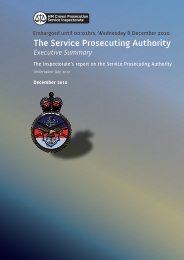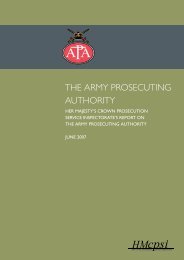Actions speak louder: A second review of healthcare in ... - HMCPSI
Actions speak louder: A second review of healthcare in ... - HMCPSI
Actions speak louder: A second review of healthcare in ... - HMCPSI
Create successful ePaper yourself
Turn your PDF publications into a flip-book with our unique Google optimized e-Paper software.
FINDINGS<br />
ACTIONS SPEAK LOUDER<br />
Local variations have been developed not only <strong>of</strong> the forms be<strong>in</strong>g used, but also<br />
<strong>of</strong> the specific criteria be<strong>in</strong>g used for onward referrals.<br />
One recent <strong>in</strong>dependent <strong>review</strong> <strong>of</strong> London YOTs found that “a wide range <strong>of</strong><br />
assessment tools is used with the most common be<strong>in</strong>g a standard CAMHS<br />
assessment”. This study also found that “there are widely differ<strong>in</strong>g views about the<br />
usefulness <strong>of</strong> SQIFA and a general impression that Asset is <strong>in</strong>adequate for mental<br />
health referral.” (Ref. 3) The lack <strong>of</strong> consistency and confidence <strong>in</strong> the tools be<strong>in</strong>g<br />
used does not help with cont<strong>in</strong>uity <strong>of</strong> care or the relationships between, and<br />
contribution by, partner agencies.<br />
Despite there be<strong>in</strong>g even more variations <strong>in</strong> the assessment forms for substance<br />
misuse services, a child or young person was far more likely to be assessed by<br />
a specialist <strong>in</strong> that field and was therefore more likely to receive an appropriate<br />
<strong>in</strong>tervention <strong>in</strong> community and custodial work. However, assessments <strong>of</strong> mental<br />
or emotional health were <strong>of</strong>ten not well understood by YOT case managers, and<br />
there were too many <strong>in</strong>consistencies <strong>in</strong> cases that led to specialist referrals. In one<br />
example, SQIFA was not consistently be<strong>in</strong>g used as a screen<strong>in</strong>g tool to assess the<br />
emotional and mental health needs <strong>of</strong> children and young people. In this <strong>in</strong>stance,<br />
SQIFA had not been used where a need had been identified <strong>in</strong> six out <strong>of</strong> eight<br />
relevant cases <strong>in</strong>spected. Clearly, if YOTs have issues with the recommended<br />
assessment framework, this needs to be tackled so that thorough, useful and<br />
consistent methods are be<strong>in</strong>g used to assess needs.<br />
The best current examples <strong>in</strong> preventative work <strong>of</strong>fer a holistic assessment at<br />
the po<strong>in</strong>t <strong>of</strong> engagement with a child or young person, which allows the service to<br />
p<strong>in</strong>po<strong>in</strong>t the most visible health needs to address. Well-<strong>in</strong>formed YOT key workers<br />
either carried out this assessment or, through clear and specific criteria, a referral<br />
was made to a health specialist to complete the assessment. There were also<br />
specific <strong>of</strong>fend<strong>in</strong>g services where a health practitioner (for example, a <strong>second</strong>ed<br />
school nurse) <strong>of</strong>fered an assessment to all children and young people com<strong>in</strong>g <strong>in</strong>to<br />
contact with the YOT before predom<strong>in</strong>antly us<strong>in</strong>g universal health services (such<br />
as a GP) to address needs.<br />
19








